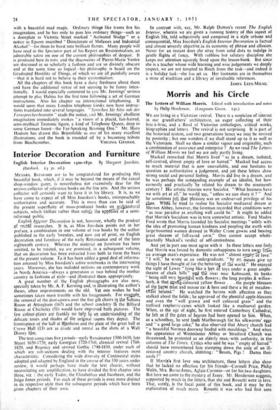Morris and his Circle
We are living in a Victorian revival. There is a suspicion of interest in our grandfathers' architecture, an eager collecting of their bric-a-brac, and a flood of Victorian anthologies, critical works, biographies and letters. The revival is not surprising. It is part of the historical system, and two generations hence we may be revived by posterity ; but one wonders if we shall stand up to it as well as the Victorians. Shall we show a similar vigour and originality, such a combination of assurance and enterprise ? As we read The Letters of William Morris we feel we are only partly living.
Mackail remarked that Morris lived " as in a dream, isolated, self-centred, almost empty of love or hatred." Mackail had access to much material that is now unavailable, and one hesitates to question so authoritative a judgement, and _yet these letters show strong social and personal feeling. Morris did live in a dream, and he was perhaps the outstanding example of an idealist, but how earnestly and practically he related his dream to the nineteenth century 1 His artistic theories were Socialist. ".What business have we with art at all," he would say, "unless we can share it ? " And he sometimes felt that pleai-ure was an undeserved privilege of his Glass. When he tried to realise his Socialist mediaeval dream at Merton Abbey, however, the foreman recorded that conditions were " as near paradise as anything well could be." It might be added that Morris's Socialism was in turn somewhat artistic. Ford Madox Ford wrote that Morris founded his Socialist meetings " solely with the idea of promoting human kindness and peopling the earth with large-bosomed women dressed in Walter Crane gowns and bearing great sheaves of full-eared corn." One cannot accept whole- heartedly Mackail's verdict of self-centredness.
And yet in part one must agree with it In these letters one feels that Morris was forced by domestic unhappiness to turn away frgij an average man's experience. He was not " almost err pty. of love." " I will," he wrote as an undergraduate, " by nt: means give up things I have thought of for the bettering of tne world." He enjoyed the sight of Lewes " lying like a tiox. a toys under a great amphi- theatre of chalk hills " and the river near Kelmscott, its banks " being still very bsautifut with flowers ; the long purples & willow- herb, & that stroq-Coloured yellow flower . . the purple blossom of tç Imse mint and mouse ear & here and there a bit of meadow- 8WEet belated." He watched the herons with affection as they stalked about the fields ; he approved of the plentiful apple-blossom and even the " well grown and well coloured grass ' and the trellised raspberry-canes which looked like a mediaeval garden. When, at the age of eight, he first entered Canterbury Cathedral, he felt as if the gates of heaven had been opened to him. When, as a schoolboy, he sent froth Marlborough for his silkworms' eggs and " a good large cake," he also observed that Abury church had " a beautiful Norman doorway loaded with mouldings." And when the appearance of Westminster Abbey or Stratford Church was threatened, he protested as an elderly man,-with authority, in the columns of The Times. Critics who said he was " empty of hatred" should have remembered him stamping down the aisle of an ill- restored country church, shotaing: "Beasts, Pigs ! Damn their souls 1"
if Morris's first love was architecture, these letters also show that he lacked no affection for his friends—Cormell Price, Philip Webb, Mrs. Burne-Jones, Aglaia Coronio—or for his two daughters. But here we come to the mystery of Janey. Mr. Henderson suggests, supported by much in the letters, that she and Rossetti were in love. That, surely, Is the focal point of this book, and it may be the explanation of much more. Rossetti it was who had first seen
Jane- Bu—rilen at.Oiroid. She was the incarnation orLiBelOiseult and the daughter of a groom in Holywell, and the one fact accounts for her fascination for Morris and the other for her unsuitability. Morris. who had to marry a remarkably beautiful woman, needed a robust and intellectual wife: We are told that Janey was high- spirited, but we infer from the letters that she was rather as Henry James described her, " strange, pale, livid, gaunt, silent "; and there must have been many other evenings when she lay on the sofa, with -her handkerchief over her face, while Morris tried to lose himself in literature.
When Rossetti entrenched himself at Kelmscott, Morris went to Iceland, and Love is Enough, which he wrote on his return. was an ironic morality. He abandoned a novel about unrequited love because, Mr. Henderson believes, " he could not resolve the problem he had posed himself," and yet he could not forget the theme. He broke with Rossetti (but Janey went down to stay with Rossetti at Bognor) ; he never, one feels, unburdened himself to her as he did to his close friends ; and time and again he spoke of his one failure in life. Much will be explained when' we are allowed to read the letters between Rossetti and Jane, and let us hope that after all we shall do so before 1989, for until then we shall never understand







































 Previous page
Previous page